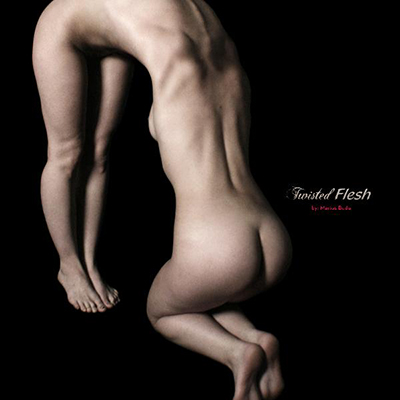While promoting the solo museum exhibition of my Twisted Flesh project, I had the pleasure of meeting the poet, art historian and critic, Mr. Pavel Şuşară. During our conversation, I found out that he had a long and rich relationship with sculpture. It was that aspect of the Twisted Flesh pieces that really spoke to him. Mr. Şuşară offered to review the project and I am very happy to share the result with you.
On flesh, dark matter and finite universes
The essential quality of Marius Budu’s photography is precisely the fact that what he is doing is not photography. And, given that I started with a negation, it should be said that the apophatic way imposes itself as the only way to identify the – at least plausible, if not true – nature of the world imagined and subsequently hypostatized by means of photography. His works cannot be considered photography for the following reasons:
- he doesn’t move in the real world and doesn’t interact with the environment
- his camera, by which I mean that lens system indispensable to any photographer, doesn’t capture anything from the outside, has no hesitation and cuts into nothing
- the resulted image makes no referral to any previous thing, mediates no relation, has no air, no earth and no patch of sky
- his images have no history, becoming thus timeless, have no context, becoming thus non-spatial, and don’t record any moment of being, which renders them simply inhuman
- no matter how long you look at them, they offer nothing predictable and comply with no logic of one’s own experiences, from the first-hand experience of identification, stretching to the more vague one of approximations shaped by distant nostalgias or more accessible melancholies
The negations could go on and on to the edge of collapse, of reaching the other realm, where their meaning reverses and becomes, justifiably, affirmation. And once it becomes affirmation, we could fully argue that Marius Budu’s photography is simply… sculpture. An endless praise of the flesh, of the anatomy, of its great and inexhaustible complexity, of its eternal and heavenly purity, which has never been banned and is, forever, protected from the fall into history.
Whoever has the naivety to think it is not sculpture because it lacks the explicit spatiality and it is not vulgarly tridimensional, has also the imprudence of revealing the limits of their understanding. Before gaining its tangible expression, before incarnating, permanently and irreparably, into substance, before falling into the space-time vulgate, the form born in the imaginary, in the residual pattern that continues the first gesture of the Creation, the Great Act of Inception, will rest ineffably for a moment in an intermediate realm, where it already possesses everything but its passing nature. Marius Budu’s photography represents precisely this in limbo sculpture, fully created yet still unborn. It is a world in the making, dreaming of its own androgyny, a crack in the nothingness, a slit of light in the most merciless night, a cosmic embryo that has not yet reached self-consciousness, living therefore beyond limitations and moral laws its ecstasy of pure and eternal voluptuousness. These images only appear to be anthropomorphic, finite universes, glosses on our own corporality – clenched, acephalous, ecstatic; they are essentially the promise of a new species, some kind of tethered fetuses, enlightened flesh in an opaque universe, in an infinite spread of dark matter.
If we were to talk about photography, be it only for the sake of conforming to the code, Marius Budu’s photography is a genuine visionary exercise, somewhat divergent, one eye turned to the sky, the other to the abyss of being, to the great mystery of DNA itself.
Pavel Şuşară
Art critic and historian
(The text was translated from Romanian by Veronica Ungureanu)
Twisted Flesh Art Book
“Each Twisted Flesh piece tells its own story. They challenge the viewer in a unique way and beckon them to explore the intricacy and variety of relationships to our physical selves that each one of us embodies.”
Pick up your copy of this beautiful collector’s item on Blurb:






